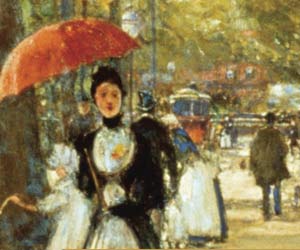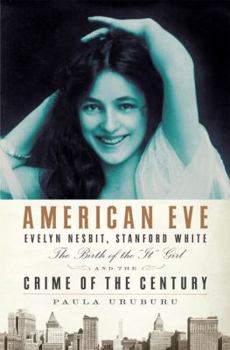American Eve: Evelyn Nesbit, Stanford White, the Birth of the "It" Girl, and the Crime of the Century
Select Format
Select Condition 
Book Overview
GOLD MEDAL WINNER -Moonbeam Awards This description may be from another edition of this product.
Format:Hardcover
Language:English
ISBN:1594489939
ISBN13:9781594489938
Release Date:May 2008
Publisher:Riverhead Books
Length:386 Pages
Weight:1.39 lbs.
Dimensions:1.1" x 6.3" x 9.3"
Age Range:18 years and up
Grade Range:Postsecondary and higher
Customer Reviews
6 ratings
Can't imagine
Published by Reader , 2 months ago
Never Got The Book. Sent Whale????Instead
Don't like Evelyn, love the book
Published by Thriftbooks.com User , 16 years ago
In turn of the century New York, Pennsylvania-born Florence Evelyn Nesbit was a famous teen beauty. Her waterfall of dark red hair, heart-shaped face, and expression of unawakened sexuality put her in hot demand as a model, therefore her image graced calendars, sheet music covers, and printed ads. Canadian author Lucy Maud Montgomery used one of Nesbit's photos as inspiration for the heroine of her bestseller "Anne of Green Gables". She shone in the Floradora chorus and her stage-door admirers included some of the wealthiest men in New York. She had her pick of suitors, and could have married well. Instead, she attracted two moral lepers disguised as rich gentlemen, and let them use her alternately as a sex toy and a pawn. The first was famed architect Stanford White, who drugged and deflowered her. The second was Pittsburgh millionaire and raging sadist Harry Kendall Thaw, who beat and raped her in a remote European castle, and married her partly out of mad infatuation, partly from a determination that his hated enemy Stanford White should never have her again. Thaw made sure the latter event could never come to pass when he shot and killed White in June 1906. Thaw's trial for murder dominated headlines throughout the world and made Evelyn a universal object of lust and fascination. When Thaw's family cast her adrift after he was sentenced to an asylum for the criminally insane, Nesbit returned to the stage. She became a vaudeville performer, silent film actress and cafe manager. In 1910 she bore a son, whom she always insisted was the result of a conjugal visit with Harry, but Thaw denied paternity. Evelyn spent years fighting alcoholism and morphine addiction, and attempted suicide more than once. She seems to have regained control of her life in her twilight years: she acted as a technical adviser on the 1955 movie "The Girl in the Red Velvet Swing". Nesbit died in Santa Monica, California, in January 1967. I wasn't prepared to like this book because I simply don't find Evelyn Nesbit to be a sympathetic figure. She let herself be used by two wealthy and powerful degenerates, and married a man who'd whipped her bloody not too long before. While I retain my negative opinion about her moral standards, "American Eve" has shown her to be quick witted, intelligent, and sensitive. In reconstructing the early years of this `child woman', Paula Uruburu relies heavily on Nesbit's two published memoirs, therefore injecting a lot of her subject's voice and personality into the book. She also interviewed Evelyn's grandson, Russell. The result is a well-written biography that may be the closest we will ever come to knowing Evelyn Nesbit personally. Even if you're not too fond of her, you can't help but enjoy "American Eve".
I wish I could give this book 6 stars!
Published by Thriftbooks.com User , 16 years ago
I haven't finished reading it yet because I'm trying to drag it out as long as I can. First of all, it's a fascinating and terrible story but Ms. Uruburu has done an incredible job in building the plot to just where it needs to go, keeping the tension as tight as possible to propell the reader into the next portion of the story. Outstanding! There is no other word for such a fine piece of writing, such an enthralling piece of writing.
ALL ABOUT EVE...
Published by Thriftbooks.com User , 16 years ago
Paula Uruburu's AMERICAN EVE: EVELYN NESBIT, STANFORD WHITE, THE BIRTH OF THE "IT" GIRL AND THE CRIME OF THE CENTURY is a first-rate, spirited and entertaining chronicle involving sex, celebrity, murder, media frenzy and a dead hippo. Uruburu's exhilarating tale begins in NYC during the final hours of 1899--an "Eden" where Nesbit, the titular Eve and "Little Sphinx," rises from poverty and obscurity to become the preeminent model and pin-up girl of the day. Part Ophelia, part Salome, the inscrutable Nesbit (also an actress and Gibson girl) captures the fancy of famed architect Stanford White, the "Pharaoh of Fifth Avenue" whose contributions to the "priapic city" included the gilded bronze weathervane of a scandalously nude Diana--appropriately, the goddess of the hunt and chastity--that sat atop the second Madison Square Garden (which White designed). Notorious for plucking ripe "tomatoes" from the stage to add to his Garden, the married, lustful and predatory "Great White" (who was three times Nesbit's age) fawns over Nesbit, wooing her with money, charm and a red velvet swing. Although Nesbit was only 16, White initiates the fall of this Eve during a night of lights, mirrors, a canopied bed and too much champagne. Awakening in "an abbreviated pink undergarment" and with a nude White next to her, Nesbit is told by the architect, "Don't cry kittens. It's all over. Now you belong to me." Not quite. Enter Mad Harry--Harry K. Thaw of Pittsburgh--with a carnivorous appetite and penchant for forbidden fruit as well. The heir-apparent to a $40 million coke and railroad fortune, Thaw was a puritanical vigilante with a history of mental illness and a hatred for White. Nesbit is initially wary of Thaw's dichotomous personality--he could be charming and tyrannical, solicitous and sadistic--and her instincts (which she ignores) unfortunately prove sound, as the 17-year-old Nesbit suffers another violation, and one night is raped and beaten with a leather riding crop by Thaw. Nesbit's relationship with Thaw and White--both men are hedonistic, controlling and bitter rivals--is compelling and, ultimately, sad, as Thaw's virgin complex and mounting obsession with White's despoilment of Nesbit leads to murder and Nesbit's downfall in White's Garden: On June 25, 1906, three shots ring out during a performance of Mamzelle Champagne. As White drops dead to the floor, Thaw shouts in defense, "I did it because he ruined my wife!" AMERICAN EVE then chronicles the "Crime of the Century" and the media storm that followed--an explosion of yellow journalism and the defamation and assassination of Nesbit's character--the woman who "put one man in the grave and another in the bughouse." Uruburu's depiction of the protracted court case is tiptop and accentuates her greatest strength as a biographer: the ability to inject verve, vitality and narrative flair into a historical account. AMERICAN EVE is peppered with colorful prose, humor and élan that spring off the page
Wonderful read - meticulous research
Published by Thriftbooks.com User , 16 years ago
I've been waiting eons for this book to be published, and it was 10 years in the making. Uruburu's look at the life and tragedy of Evelyn Nesbit is a fascinating page-turner that finally places Nesbit in her correct time period. Although she looks modern, she was a girl trapped and exploited by the standards of her time. Her beauty lifted her into the high life of 1900s New York City, but it also led her down a tragic path of madness and murder. Although the previous reviewer is correct that the term "It Girl" didn't come into play until Clara Bow in the 1920s, author Uruburu states that Nesbit was the "It Girl" of the turn of the last century, and I agree. Nesbit's life and the 1906 murder of Stanford White still fascinate, and this is one of the best books on the subject.
The definitive book on one of the most sensational crimes of the 20th Century
Published by Thriftbooks.com User , 16 years ago
In the first years of the 20th century, one of the most famous women in America was a teenager, Evelyn Nesbit, a model for artists and photographers and New York showgirl. She was ubiquitous in advertisements and magazines, and had a kind of innocent beauty that also possessed a measure of sophistication. She was courted by many stage-door millionaires, but it was Stanford White, renowned architect, who made her his mistress. Later she would marry an unbalanced millionaire, Harry K. Thaw of Pittsburgh, who would learn that White spoiled his child-bride and during the summer of 1906, in the rooftop theater of Madison Square Garden, a building White designed, Thaw would murder White and cast Nesbit as the focal point of the first American trial that would become a media circus. Nesbit's story, and the tale of murder and insanity that accompanies it, is brilliantly told in Paula Uruburu's book American Eve: Evelyn Nesbit, Stanford White, The Birth of the "It" Girl, and the Crime of the Century. While the appelation It Girl is incorrect (that was Clara Bow some twenty years later), Nesbit was certainly the first model to gain national attention. Her humble upbringing from a Pittsburgh suburb to full-time model at age 14 is layed out in scrupulous detail, as is her seduction by White and courtship with the mad Harry. What Uruburu seems most keen on doing here is setting the record straight--Nesbit was vilified by many in the press at the time of the murder and trial. As Uruburu points out, she was more sinned against than sinning, a girl who was neglected by her mother and allowed to be exploited by the rapacious men of the age. Uruburu's book is Evelyn's story, told largely from her viewpoint (making large use of Evelyn's two memoirs) and by the end of the book it is clear that she was a victim of circumstance and her own beauty. The book is carefully researched, with as much detail as the reader would want without being bogged down in too many facts and figures. The chapters describing White's seduction and subsequent deflowering of Evelyn read partly as history, partly as erotic novel, with the reader's senses saturated to overflowing. The chapter depicting the shooting is as tense and exciting as a thriller, and the trial (there were actually two) is rendered in novelistic fashion, with the emotions on display, rather than laborious recitations of transcripts. Perhaps the best thing about the book is the style of writing. This is no dry academic tome, nor is it a non-fiction novel. It is biography and history, but with a delightfully mordant drollery. Uruburu never passes up a chance to inject levity into the proceedings, whether it be referring to a low-rent lawyer's reputation being as checkered as his suit, or Harry Thaw's sisters looking like Harry in fright wigs. She also allows frequent glimpses of what was going on in the first decade of the 1900s, interspersing other headlines of the day in context, whether they be the assassination of
American Eve: Evelyn Nesbit, Stanford White, the Birth of the "It" Girl and the Crime of the Century Mentions in Our Blog

The Gilded Age
Published by William Shelton • January 23, 2022
One of the most exciting, and prosperous, periods of American history came upon the heels of the most tragic time for our country. The Civil War and Reconstruction gave way to a generation where the amassing of tremendous wealth was the order of the day, conspicuous consumption the only guiding principle, and the gap between the "haves" and the "have nots" was the greatest that the United States would ever see.






